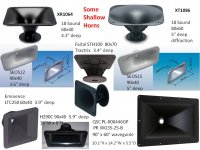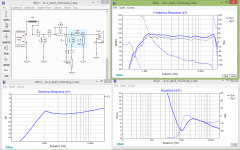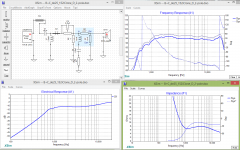yeah - guess keep it simple - forget the Econowave/Pi spiel from me. I need to order pads -100 watt rated ones are pretty tough. What starting value would you suggest for DE25 with a QSC waveguide to work with ~95dB - 99dB woofer?
freddi,
I can post a network schematic tomorrow if you like ( for that driver/horn combo ).
- I still need to create a .zma file for the de25/152iClone combo.
FWIW, I might not have posted my previous offering ( post #80 ) if I had seen your post ( #79 ) .
🙂
I can post a network schematic tomorrow if you like ( for that driver/horn combo ).
- I still need to create a .zma file for the de25/152iClone combo.
FWIW, I might not have posted my previous offering ( post #80 ) if I had seen your post ( #79 ) .
🙂
that would be very nice to see. I think I have one DE25 bolted to a QSC WG - was hoping to use it in conjunction with either a 15tbx40 or 15pzb40 (those might make nice tapped pipe/horn ~30-35Hz subs)
Thanks EarlK! Connected several different cap values this morning. This definitely works! A heaviness was lifted from vocalists and the sound is ligh, airy and detailed. Started with 4uf (too bright) and worked my way down to 1.33uf on the QSC WG. This will help tremendously in fine tuning the sound of the various horns I bought. Awesome!
When using passive crossovers... Physical time alignment between the CD+horn and the midrange speaker is sometimes simplified by selecting the correct shallow depth horn. Data from the AVSforum shows only a few mm offset between the AES TD12M, and SEOS-12 with BC250 CD.
Much greater challenges when using a 17.1" deep JMLC 350 with your 1" compression driver. 🙂
Phase and Time. You can download crossover spreadsheets which model how to mix-and-match crossover slopes, and T-M crossover freq_shift to reduce the time delay ripples.
e.g: There is a 1.7 cm physical difference between a Faital HF108 on a SEOS-15, and a Beyma 12P80Nd. Using a LR4@1400Hz for the HF108 and LR4@1370 for the 12P80Nd reduces the time glitch to less than 0.1db ripple.
Much greater challenges when using a 17.1" deep JMLC 350 with your 1" compression driver. 🙂
Phase and Time. You can download crossover spreadsheets which model how to mix-and-match crossover slopes, and T-M crossover freq_shift to reduce the time delay ripples.
e.g: There is a 1.7 cm physical difference between a Faital HF108 on a SEOS-15, and a Beyma 12P80Nd. Using a LR4@1400Hz for the HF108 and LR4@1370 for the 12P80Nd reduces the time glitch to less than 0.1db ripple.
Attachments
that would be very nice to see. I think I have one DE25 bolted to a QSC WG - was hoping to use it in conjunction with either a 15tbx40 or 15pzb40 (those might make nice tapped pipe/horn ~30-35Hz subs)
Here's a network for the de25/152iClone combo. ( C2 & L1 aren't in the circuit ).
The two traces ( in the FR window ) show the difference between dialing in 3db of attenuation from the variable Lpad ( R6 + R7 in the schematic ).
Changing C3 from 3uF to 6uF will essentially flatten the trace.
🙂
Attachments
Last edited:
that would be very nice to see. I think I have one DE25 bolted to a QSC WG - was hoping to use it in conjunction with either a 15tbx40 or 15pzb40 (those might make nice tapped pipe/horn ~30-35Hz subs)
Here's a 3-pole variant ( with the 3-pole Hi-Pass also acting as a bump circuit > ie; boost EQ ) designed to push the driver down to a lower X-over point ( while still keeping the general sensitivity up ) .
This H-Pass would be harder to actually implement due to the 4 ohm dip seen at around 1.050K ( as well as a largish group delay figure around 1050 hz ).
- Adding some fractional load resistance (at R4 ) would address some of these concerns .
🙂
Attachments
Last edited:
that would be very nice to see. I think I have one DE25 bolted to a QSC WG - was hoping to use it in conjunction with either a 15tbx40 or 15pzb40 (those might make nice tapped pipe/horn ~30-35Hz subs)
And here's a 2-pole variant.
I'd be inclined to start with this & then see if it could be massaged to work with a 4-pole low-pass.
R4 & C2 are short-circuited ( straight pieces of wire ).
🙂
Attachments
Just found the time to run some tests.
Dayton D250P w/H812
Crossover 1K25/6dB

Selenium D280Ti w/H812
Crossover 1K25/6dB

The Dayton D250P is brand new. Bought in Aug this year. Even my Pyle compression drivers have lower distortion. 😱
Regards
Mike
Dayton D250P w/H812
Crossover 1K25/6dB

Selenium D280Ti w/H812
Crossover 1K25/6dB

The Dayton D250P is brand new. Bought in Aug this year. Even my Pyle compression drivers have lower distortion. 😱
Regards
Mike
You're welcome.
Frankly, I haven't heard the D250P yet.
I will be testing my other compression drivers with the H612.
After that, I'll go back to the D250P and play some music.
Will keep you posted.
Mike
Frankly, I haven't heard the D250P yet.
I will be testing my other compression drivers with the H612.
After that, I'll go back to the D250P and play some music.
Will keep you posted.
Mike
The two earlier plots were not accurate because I was using the crossovers in the PIONEER FH-X731BT.
These new measurements are without the Pioneer. Sweep signal to power amplifier. Amp direct to comp drv. Sweep is with BASS REMOVED to protect drv.
This is the Selenium D220Ti with the Dayton H812 horn.

And here is the Dayton D250P with the H812.

ORANGE trace is 2nd Harmonic
VIOLET trace is 3rd Harmonic
Quite high distortion in the Dayton D250P.
These new measurements are without the Pioneer. Sweep signal to power amplifier. Amp direct to comp drv. Sweep is with BASS REMOVED to protect drv.
This is the Selenium D220Ti with the Dayton H812 horn.

And here is the Dayton D250P with the H812.

ORANGE trace is 2nd Harmonic
VIOLET trace is 3rd Harmonic
Quite high distortion in the Dayton D250P.
The Distortion plots are meant to measure distortion. They do not give an accurate picture of frequency response.
The following plots are the right ones for FR.
This is the Selenium D220Ti with H812 at RAW, 1K25/24dB and 1K6/24dB

And here is the Dayton D250P with the H812 also at RAW, 1K25/24dB and 1K6/24dB

Clearly, the Selenium D220Ti is flatter and goes lower than the Dayton D250P.
I still haven't had the chance to listen to them yet because I'm testing out my collection of compression drivers with all the horns that I have.
Will let you know once I get some music out of them.
The following plots are the right ones for FR.
This is the Selenium D220Ti with H812 at RAW, 1K25/24dB and 1K6/24dB

And here is the Dayton D250P with the H812 also at RAW, 1K25/24dB and 1K6/24dB

Clearly, the Selenium D220Ti is flatter and goes lower than the Dayton D250P.
I still haven't had the chance to listen to them yet because I'm testing out my collection of compression drivers with all the horns that I have.
Will let you know once I get some music out of them.
Not really. Look at the response from 9k+, IMO, it is unacceptable.The D220Ti measures much better than it sounds!
I believe Omnimic distortion measurement stop @ 10k.True, some nasty ringing
Does break up not usually show up in distortion measurments?
Hi Michael

With a tiny bit of effort I'm quite confident that you can get rid of that (5db) 2-3K suck-out and at the same time improve the distortion spec.( on your D250P drivers) .
I had this raw response ( DT250P on a H6512 ) with an almost identical suck-out ( note "relaxed" vertical scale ) ;
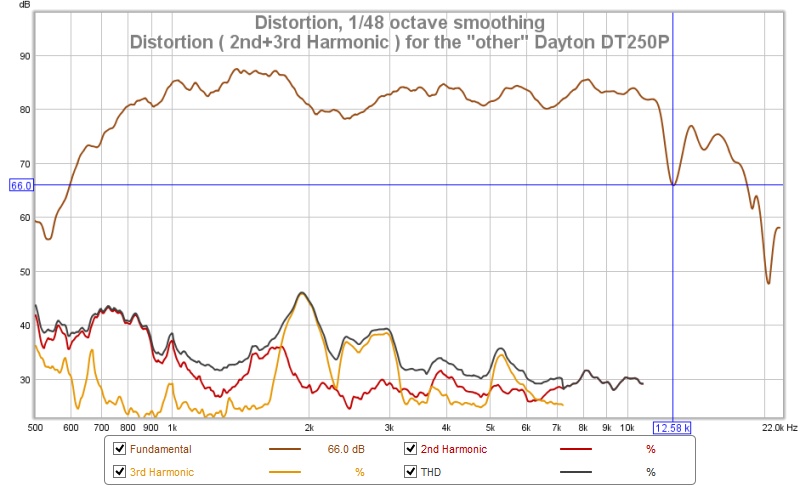
and was able to manage this ( driver now on a H812 horn )( note "critical-viewing" vertical scale ) ;
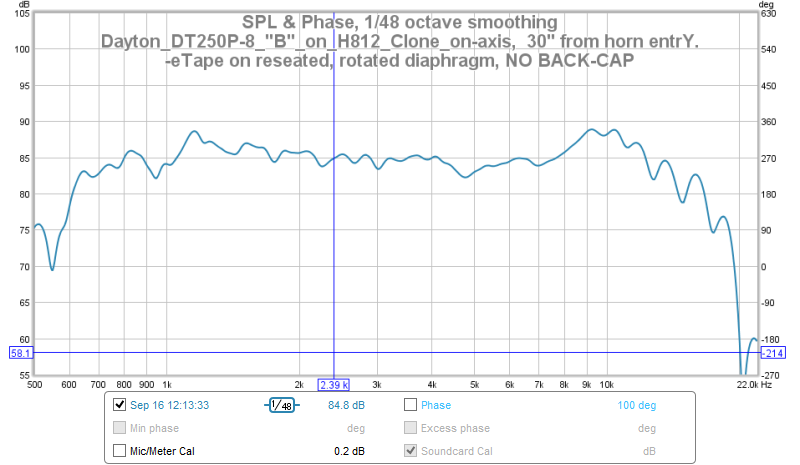
- The distortion went down to negligible levels after rotating the diaphragm 180deg in the gap ( and ensuring it was re-centered ).
My drivers were eventually sent back due to the back-caps being warped ( & therefore not suitable for SR work when placed inside a cabinet ).
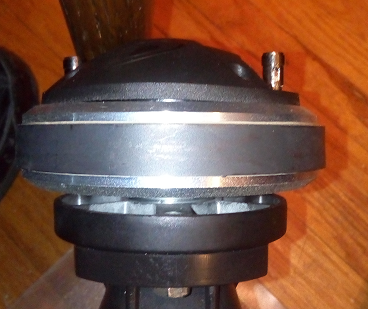
🙂

With a tiny bit of effort I'm quite confident that you can get rid of that (5db) 2-3K suck-out and at the same time improve the distortion spec.( on your D250P drivers) .
I had this raw response ( DT250P on a H6512 ) with an almost identical suck-out ( note "relaxed" vertical scale ) ;

and was able to manage this ( driver now on a H812 horn )( note "critical-viewing" vertical scale ) ;

- The distortion went down to negligible levels after rotating the diaphragm 180deg in the gap ( and ensuring it was re-centered ).
My drivers were eventually sent back due to the back-caps being warped ( & therefore not suitable for SR work when placed inside a cabinet ).

🙂
- Status
- Not open for further replies.
- Home
- Loudspeakers
- Multi-Way
- Dayton DT250P-8 compression tweeter sings
